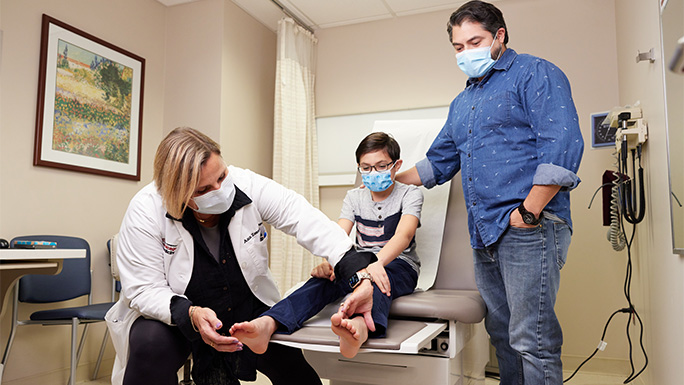Foot and Ankle Care for Children

Foot and ankle experts at the University of Chicago Medicine Comer Children’s Hospital understand the unique foot and ankle conditions children are prone to, and our goal is to deliver your child with personalize care to meet his/her healthcare needs and long-term aspirations.
Our team treats everything from straightforward orthopaedic injuries to highly complex foot and ankle problems. We take an active role in educating the parents and patients about what options are available, and what therapies would be best suited for their individual condition.
Foot and Ankle Conditions We Treat
When a child has cavus foot, it’s described as having an unnaturally high arched foot or feet. The height of the arch can vary, and will determine how much pressure is placed on ball and heel of the foot/feet.
If not treated, cavus foot can make everyday activities, such as standing or walking, painful. Depending on the severity of your child’s cavus foot, we offer a wide range of treatment options, including:
- Arch supports
- Corrective shoes
- Bracing
- Surgery
If your child is suffering because of flatfoot, reaching out to expert orthopaedists who specialize in pediatrics can help identify the problem and recommend the best treatment(s) for your child.
Some children are born with gait abnormalities while other kids can develop issues as they grow. A gait abnormality is characterized by odd or atypical walking patterns, including:
- Bowlegged
- Knocked knees
- Limping
- Toe walking
- In-toeing
- Out-toeing
Our pediatric orthopaedic team will work with you and your child to diagnose his/her gait condition and create a treatment plan that will provide the best long-term quality of life. Treatment plans may consist of one or more therapies:
- Monitoring
- Serial casting
- Bracing
- Physical therapy
- Surgery
This condition is usually noticed in adolescence since the accessory navicular doesn’t develop until your child is near his/her teenage years. If the condition worsens, causing pain and/or function/mobility limitations, our orthopedists can evaluate your child’s foot to determine what treatment(s) would be best.
In a healthy foot, the tarsal bones can shift to allow motion, but for children with tarsal coalition, one of more of these bones connect abnormally, which can limit or eliminate mobility and/or be painful.
Comer Children’s orthopaedic team has the experience to diagnose tarsal coalition and create a tailored treatment plan for your child that can restore mobility, function and daily activity.
